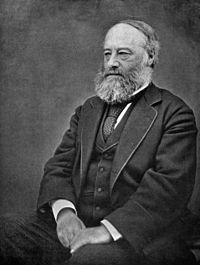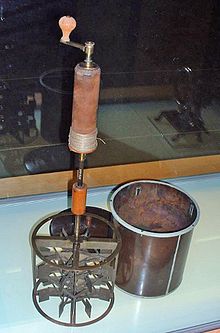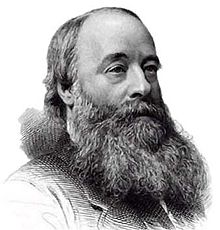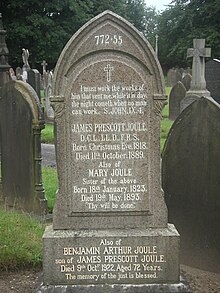James Prescott Joule
James Prescott Joule | |
|---|---|
 James Joule – Physicist | |
| Born | 24 December 1818 Salford, Lancashire, England, UK |
| Died | 11 October 1889 (aged 70) Sale, Cheshire, England, UK |
| Citizenship | British |
| Known for | First Law of Thermodynamics |
| Scientific career | |
| Fields | Physics |
James Prescott Joule FRS (/[invalid input: 'icon']dʒuːl/;[1] 24 December 1818 – 11 October 1889) was an English physicist and brewer, born in Salford, Lancashire. Joule studied the nature of heat, and discovered its relationship to mechanical work (see energy). This led to the theory of conservation of energy, which led to the development of the first law of thermodynamics. The SI derived unit of energy, the joule, is named after him. He worked with Lord Kelvin to develop the absolute scale of temperature, made observations on magnetostriction, and found the relationship between the current through resistance and the heat dissipated, now called Joule's law.
Early years

The son of Benjamin Joule (1784–1858), a wealthy brewer, and Alice Prescott Joule, James Prescott Joule was born in the house adjoining the Joule Brewery in New Bailey Street, Salford 24 December 1818.[2] James was tutored at the family home 'Broomhill', Pendlebury, near Salford, until 1834 when he was sent with his elder brother Benjamin, to study with John Dalton at the Manchester Literary and Philosophical Society.[2] The pair only received two years' education in arithmetic and geometry before Dalton was forced to retire owing to a stroke. However, Dalton's influence made a lasting impression as did that of his associates, chemist William Henry and Manchester engineers Peter Ewart and Eaton Hodgkinson. Joule was subsequently tutored by John Davies. Fascinated by electricity, he and his brother experimented by giving electric shocks to each other and to the family's servants.[3]
Joule became a manager of the brewery[4] and took an active role until the sale of the business in 1854. Science was a hobby but he soon started to investigate the feasibility of replacing the brewery's steam engines with the newly invented electric motor. In 1838, his first scientific papers on electricity were contributed to Annals of Electricity, the scientific journal founded and operated by Davies's colleague William Sturgeon. He formulated Joule's laws in 1840[5] and hoped to impress the Royal Society but found, not for the last time, that he was perceived as a mere provincial dilettante. When Sturgeon moved to Manchester in 1840, Joule and he became the nucleus of a circle of the city's intellectuals. The pair shared similar sympathies that science and theology could and should be integrated. Joule went on to lecture at Sturgeon's Royal Victoria Gallery of Practical Science.[3]
He went on to realise that burning a pound of coal in a steam engine produced five times as much duty as a pound of zinc consumed in a Grove cell,[6] an early electric battery.[7] Joule's common standard of "economical duty" was the ability to raise one pound by a height of one foot, the foot-pound.[3][8]
Joule was influenced by the thinking of Franz Aepinus and tried to explain the phenomena of electricity and magnetism in terms of atoms surrounded by a "calorific ether in a state of vibration".[3]
However, Joule's interest diverted from the narrow financial question to that of how much work could be extracted from a given source, leading him to speculate about the convertibility of energy. In 1843 he published results of experiments showing that the heating effect he had quantified in 1841 was due to generation of heat in the conductor and not its transfer from another part of the equipment.[9] This was a direct challenge to the caloric theory which held that heat could neither be created nor destroyed. Caloric theory had dominated thinking in the science of heat since it was introduced by Antoine Lavoisier in 1783. Lavoisier's prestige and the practical success of Sadi Carnot's caloric theory of the heat engine since 1824 ensured that the young Joule, working outside either academia or the engineering profession, had a difficult road ahead. Supporters of the caloric theory readily pointed to the symmetry of the Peltier-Seebeck effect to claim that heat and current were convertible, at least approximately, by a reversible process.[3]
The mechanical equivalent of heat
Joule wrote in his 1845 paper:
... the mechanical power exerted in turning a magneto-electric machine is converted into the heat evolved by the passage of the currents of induction through its coils; and, on the other hand, that the motive power of the electro-magnetic engine is obtained at the expense of the heat due to the chemical reactions of the battery by which it is worked.[10]

Joule here adopts the language of vis viva (energy), possibly because Hodgkinson had read a review of Ewart's On the measure of moving force to the Literary and Philosophical Society in April 1844.
Further experiments and measurements by Joule led him to estimate the mechanical equivalent of heat as 838 ft·lbf of work to raise the temperature of a pound of water by one degree Fahrenheit.[11] He announced his results at a meeting of the chemical section of the British Association for the Advancement of Science in Cork in 1843 and was met by silence.
Joule was undaunted and started to seek a purely mechanical demonstration of the conversion of work into heat. By forcing water through a perforated cylinder, he was able to measure the slight viscous heating of the fluid. He obtained a mechanical equivalent of 770 ft·lbf/Btu (4.14 J/cal). The fact that the values obtained both by electrical and purely mechanical means were in agreement to at least one order of magnitude was, to Joule, compelling evidence of the reality of the convertibility of work into heat.
Joule now tried a third route. He measured the heat generated against the work done in compressing a gas. He obtained a mechanical equivalent of 823 ft·lbf/Btu (4.43 J/cal).[12] In many ways, this experiment offered the easiest target for Joule's critics but Joule disposed of the anticipated objections by clever experimentation. However, his paper was rejected by the Royal Society and he had to be content with publishing in the Philosophical Magazine. In the paper he was forthright in his rejection of the caloric reasoning of Carnot and Émile Clapeyron, but his theological motivations also became evident:
I conceive that this theory ... is opposed to the recognised principles of philosophy because it leads to the conclusion that vis viva may be destroyed by an improper disposition of the apparatus: Thus Mr Clapeyron draws the inference that 'the temperature of the fire being 1000 °C to 2000 °C higher than that of the boiler there is an enormous loss of vis viva in the passage of the heat from the furnace to the boiler.' Believing that the power to destroy belongs to the Creator alone I affirm ... that any theory which, when carried out, demands the annihilation of force, is necessarily erroneous.
In 1845, Joule read his paper On the mechanical equivalent of heat to the British Association meeting in Cambridge.[13] In this work, he reported his best-known experiment, involving the use of a falling weight, in which gravity does the mechanical work, to spin a paddle-wheel in an insulated barrel of water which increased the temperature. He now estimated a mechanical equivalent of 819 ft·lbf/Btu (4.41 J/cal).
In 1850, Joule published a refined measurement of 772.692 ft·lbf/Btu (4.159 J/cal), closer to twentieth century estimates.[14]
Reception and priority

- For the controversy over priority with Mayer, see Mechanical equivalent of heat: Priority
Much of the initial resistance to Joule's work stemmed from its dependence upon extremely precise measurements. He claimed to be able to measure temperatures to within 1⁄200 of a degree Fahrenheit (3 mK). Such precision was certainly uncommon in contemporary experimental physics but his doubters may have neglected his experience in the art of brewing and his access to its practical technologies.[15] He was also ably supported by scientific instrument-maker John Benjamin Dancer.
However, in Germany, Hermann Helmholtz became aware both of Joule's work and the similar 1842 work of Julius Robert von Mayer. Though both men had been neglected since their respective publications, Helmholtz's definitive 1847 declaration of the conservation of energy credited them both.
Also in 1847, another of Joule's presentations at the British Association in Oxford was attended by George Gabriel Stokes, Michael Faraday, and the precocious and maverick William Thomson, later to become Lord Kelvin, who had just been appointed professor of natural philosophy at the University of Glasgow. Stokes was "inclined to be a Joulite" and Faraday was "much struck with it" though he harboured doubts. Thomson was intrigued but sceptical.
Unanticipated, Thomson and Joule met later that year in Chamonix. Joule married Amelia Grimes on 18 August and the couple went on honeymoon. Marital enthusiasm notwithstanding, Joule and Thomson arranged to attempt an experiment a few days later to measure the temperature difference between the top and bottom of the Cascade de Sallanches waterfall, though this subsequently proved impractical.
Though Thomson felt that Joule's results demanded theoretical explanation, he retreated into a spirited defence of the Carnot-Clapeyron school. In his 1848 account of absolute temperature, Thomson wrote that "the conversion of heat (or caloric) into mechanical effect is probably impossible, certainly undiscovered"[16] – but a footnote signalled his first doubts about the caloric theory, referring to Joule's "very remarkable discoveries". Surprisingly, Thomson did not send Joule a copy of his paper but when Joule eventually read it he wrote to Thomson on 6 October, claiming that his studies had demonstrated conversion of heat into work but that he was planning further experiments. Thomson replied on the 27th, revealing that he was planning his own experiments and hoping for a reconciliation of their two views. Though Thomson conducted no new experiments, over the next two years he became increasingly dissatisfied with Carnot's theory and convinced of Joule's. In his 1851 paper, Thomson was willing to go no further than a compromise and declared "the whole theory of the motive power of heat is founded on ... two ... propositions, due respectively to Joule, and to Carnot and Clausius".
As soon as Joule read the paper he wrote to Thomson with his comments and questions. Thus began a fruitful, though largely epistolary, collaboration between the two men, Joule conducting experiments, Thomson analysing the results and suggesting further experiments. The collaboration lasted from 1852 to 1856, its discoveries including the Joule-Thomson effect, and the published results did much to bring about general acceptance of Joule's work and the kinetic theory.
Kinetic theory

Kinetics is the science of motion. Joule was a pupil of Dalton and it is no surprise that he had learned a firm belief in the atomic theory, even though there were many scientists of his time who were still sceptical. He had also been one of the few people receptive to the neglected work of John Herapath on the kinetic theory of gases. He was further profoundly influenced by Peter Ewart's 1813 paper On the measure of moving force.
Joule perceived the relationship between his discoveries and the kinetic theory of heat. His laboratory notebooks reveal that he believed heat to be a form of rotational, rather than translational motion.
Joule could not resist finding antecedents of his views in Francis Bacon, Sir Isaac Newton, John Locke, Benjamin Thompson (Count Rumford) and Sir Humphry Davy. Though such views are justified, Joule went on to estimate a value for the mechanical equivalent of heat of 1034 foot-pound from Rumford's publications. Some modern writers have criticised this approach on the grounds that Rumford's experiments in no way represented systematic quantitative measurements. In one of his personal notes, Joule contends that Mayer's measurement was no more accurate than Rumford's, perhaps in the hope that Mayer had not anticipated his own work. Joule is attributed with explaining the Green Flash phenomenon in a letter to the Manchester Literary and Philosophical Society in 1869.
Honours


Joule died at home in Sale[17] and is buried in Brooklands cemetery there. The gravestone is inscribed with the number "772.55", his climacteric 1878 measurement of the mechanical equivalent of heat, and with a quotation from the Gospel of John, "I must work the works of him that sent me, while it is day: the night cometh, when no man can work" (9:4). The Wetherspoon's public house in Sale, the town of his death, is named after him.
- Fellow of the Royal Society, (1850);
- Royal Medal, (1852);
- Copley Medal (1870);
- President of Manchester Literary and Philosophical Society, (1860);
- President of the British Association for the Advancement of Science, (1872, 1887);
- Honorary degrees:
- LL.D., Trinity College Dublin, (1857);
- DCL, University of Oxford, (1860);
- LL.D., University of Edinburgh, (1871).
- He received a civil list pension of £200 per annum in 1878 for services to science;
- Albert Medal of the Royal Society of Arts, (1880).
- There is a memorial to Joule in the north choir aisle of Westminster Abbey, though he is not buried there, contrary to what some biographies state.
- A statue by Alfred Gilbert, stands in Manchester Town Hall, opposite that of Dalton.
Selected writings
- Joule, J. P. (1963). The Scientific Papers of James Prescott Joule. London: Dawsons of Pall Mall.
Notes
- ^ OED: "Although some people of this name call themselves (dʒaʊl), and others (dʒəʊl) [the OED format for /dʒoʊl/], it is almost certain that J. P. Joule (and at least some of his relatives) used (dʒuːl). The Joule brewery used the confusion in its pronunciation in advertising: Childs, Stephen. "Chemical Miscellany". Chemistry in Action! (50). University of Limerick. Retrieved 24 March 2010.
- ^ a b Hulme, Charles (2010). "John Cassidy:Manchester Sculptor". John Cassidy 150th Anniversary website. Retrieved 22 March 2010.
- ^ a b c d e Smith (2004)
- ^ "Joule's Story". Joule's Brewery. Retrieved 28 July 2012.
- ^ Joule, J.P. (1841) "On the heat evolved by metallic conductors of electricity" Philosophical Magazine, 19, 260; Scientific Papers 65
- ^ William Robert Grove was to give one of the earliest general accounts of the conservation of energy in 1844.
- ^ Smith (1998) p.60
- ^ Joule's unit of the foot-pound corresponds to a modern measure of energy. The energy required to raise a mass, m, through a height h is mgh, where g is the standard gravity. Joule's unit is dimensionally correct if interpreted as foot-pound force. Where SI units are employed, such energy is given in terms of the eponymous joule: 1 foot-pound = 1.356 J.
- ^ Joule, James Prescott (1843). "On the calorific effects of magneto-electricity, and on the mechanical value of heat". Philosophical Magazine, Series 3. 23: 263–276.
- ^ Joule, James Prescott (1845). "On the Changes of Temperature Produced by the Rarefaction and Condensation of Air". Philosophical Magazine, Series 3. 26. Harper & brothers: 369.
- ^ Joule's unit corresponds to 5.3803×10−3 J/cal. Thus Joule's estimate was 4.51 J/cal, compared to the value accepted by the beginning of the 20th century of 4.1860 J/cal (M.W. Zemansky (1968) Heat and Thermodynamics, 5th ed., p. 86).
- ^ Joule, J.P. (1845) "On the rarefaction and condensation of air" Philosophical Magazine, Scientific Papers 172
- ^ Joule, J.P. (1845) "On the Mechanical Equivalent of Heat", Brit. Assoc. Rep., trans. Chemical Sect, p.31, read before the British Association at Cambridge, June
- ^ Joule, J.P (1 January 1850) "On the mechanical equivalent of heat," Philosophical Transactions of the Royal Society of London, vol.140, Part 1, pages 61–82.
- ^ Sibum (1994)
- ^ See Thomson, William (1848). "On an Absolute Thermometric Scale founded on Carnot's Theory of the Motive Power of Heat, and calculated from Regnault's Observations". Philosophical Journal.- See also the account in Thomson, William (1882). Mathematical and Physical Papers. Cambridge, England: Cambridge University Press. pp. 100–106.
- ^ GRO Register of Deaths: DEC 1889 8a 121 ALTRINCHAM – James Prescott Joule
Further reading
- Bottomley, J. T. (1882). "James Prescott Joule". Nature. 26 (678): 617–620. Bibcode:1882Natur..26..617B. doi:10.1038/026617a0.
- Cardwell, D. S. L. (1991). James Joule: A Biography. Manchester college Press. ISBN 0-7190-3479-5.
- Forrester, J. (1975). "Chemistry and the Conservation of Energy: The Work of James Prescott Joule". Studies in the History and Philosophy of Science. 6 (4): 273–313. doi:10.1016/0039-3681(75)90025-4.
- Fox, R, "James Prescott Joule, 1818–1889", in North, J. (1969). Mid-nineteenth-century scientists. Elsevier. pp. 72–103. ISBN 0-7190-3479-5.
- Reynolds, Osbourne (1892). Memoir of James Prescott Joule. Manchester, England: Manchester Literary and Philosophical Society. Retrieved 15 March 2008.
- Sibum, H. O. (1995). "Reworking the mechanical value of heat: instruments of precision and gestures of accuracy in early Victorian England". Studies in History and Philosophy of Science. 26: 73–106. doi:10.1016/0039-3681(94)00036-9.
- Smith, C. (1998). The Science of Energy: A Cultural History of Energy Physics in Victorian Britain. London: Heinemann. ISBN 0-485-11431-3.
- Smith, Crosbie (2004). "Joule, James Prescott". Oxford Dictionary of National Biography (online ed.). Oxford University Press. doi:10.1093/ref:odnb/15139. (Subscription or UK public library membership required.). The first edition of this text is available at Wikisource: . Dictionary of National Biography. London: Smith, Elder & Co. 1885–1900.
- Smith, C. & Wise, M.N. (1989). Energy and Empire: A Biographical Study of Lord Kelvin. Cambridge University Press. ISBN 0-521-26173-2.
{{cite book}}: CS1 maint: multiple names: authors list (link) - Steffens, H.J. (1979). James Prescott Joule and the Concept of Energy. Watson. ISBN 0-88202-170-2.
- Walker, James (1950). Physics 4th Edition. Pearson. ISBN 978-0-321-54163-5.
External links
- Classic papers of 1845 and 1847 at ChemTeam website On the Mechanical Equivalent of Heat and On the Existence of an Equivalent Relation between Heat and the ordinary Forms of Mechanical Power
- Joule's water friction apparatus at London Science Museum
- Some Remarks on Heat and the Constitution of Elastic Fluids, Joule's 1851 estimate of the speed of a gas molecule.
- University of Manchester material on Joule – includes photographs of Joule's house and gravesite
- . Dictionary of National Biography. London: Smith, Elder & Co. 1885–1900.
- "Dr. Joule". Electrical Engineer (18 October). London: Biggs & Co: 311–312. 1889. Retrieved 16 May 2008.- obituary with brief comment on Joule's family
- Joule Physics Laboratory at the University of Salford
- Use dmy dates from January 2012
- Ill-formatted IPAc-en transclusions
- 1818 births
- 1889 deaths
- Thermodynamicists
- Fellows of the Royal Society
- Recipients of the Copley Medal
- English physicists
- History of Greater Manchester
- People associated with energy
- People associated with electricity
- People from Sale, Greater Manchester
- Royal Medal winners
